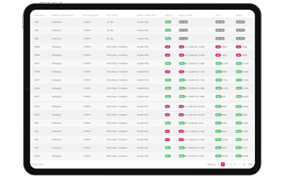In industries where electrostatic discharge (ESD) poses a significant risk—such as electronics manufacturing, semiconductor fabrication, and medical device production—protecting sensitive components is critical. A robust ESD access control system ensures that only properly grounded personnel and equipment enter controlled environments, minimizing the risk of static-related damage. However, not all ESD control solutions are equally effective. This article explores the essential features that make an ESD access control system reliable, efficient, and compliant with industry standards.
Table of Contents
1. Real-Time Grounding Verification
One of the most critical features of an effective ESD access control system is real-time grounding verification. Before granting access to an Electrostatic Discharge Protected Area (EPA), the system must confirm that the individual is properly grounded. This is typically achieved through:
ESD Floor Mat Testing: Users step on a conductive mat that checks for proper grounding.
Wrist Strap Detection: Some systems require users to plug in or wear an ESD wrist strap before entry.
Continuous Monitoring: Advanced systems continuously monitor grounding status while the person is inside the controlled area.
Without real-time verification, there’s a risk of human error, such as forgetting to ground oneself, leading to potential ESD incidents.
2. Integration with Access Control Technologies
A standalone grounding tester is not enough—effective ESD access control systems must integrate with broader security and facility management systems. Key integration features include:
RFID/Badge Readers: Only authorized personnel with valid access credentials can enter.
Biometric Scanners: Fingerprint or facial recognition ensures that only trained and approved staff gain access.
Interlock Doors & Turnstiles: Prevents tailgating (unauthorized personnel following someone in).
This integration ensures that both security and ESD compliance are enforced simultaneously.
3. Compliance Logging & Reporting
Industries such as semiconductor manufacturing must adhere to strict ESD standards like ANSI/ESD S20.20 or IEC 61340. An effective ESD access control system should automatically log:
- Entry & exit times of personnel.
- Grounding compliance status (whether checks were passed or failed).
- Failed access attempts, including reasons (e.g., missing wrist strap, improper grounding).
These logs are crucial for audits, quality control, and troubleshooting ESD-related failures. Additionally, as industrial environments adopt advanced tools like industrial 3D cameras to boost precision and efficiency, integrating such technologies with ESD systems enhances monitoring and traceability.
4. Alarm & Alert Systems
Even with automated checks, some individuals might attempt to bypass protocols. A high-quality ESD access control system should include:
Visual & Audible Alarms: Immediate alerts if someone fails a grounding test.
Software Notifications: Real-time alerts sent to supervisors or ESD control managers.
Lockout Features: Temporarily restricting access for repeat violators until retraining is completed.
These features ensure immediate corrective action, reducing the risk of ESD damage.
5. Scalability & Customization
Different facilities have varying ESD control needs. An effective system should be:
Modular: Allows adding more checkpoints as the facility expands.
Configurable: Adjustable sensitivity for grounding tests based on industry requirements.
Compatible with Existing Infrastructure: Works with current security systems (CCTV, building management software).
This flexibility ensures long-term usability across different production environments.
6. User-Friendly Interface
If the system is too complicated, employees may resist using it. Key usability features include:
Touchscreen Displays: Simple instructions for users.
Multilingual Support: Useful in global manufacturing facilities.
Quick Troubleshooting Guides: Helps users correct grounding issues (e.g., adjusting wrist straps).
A well-designed interface improves compliance rates and reduces training time.
Conclusion
An effective ESD access control system is more than just a grounding checkpoint—it’s a comprehensive solution that integrates real-time verification, access control, compliance tracking, and user-friendly design. By implementing a system with these key features, companies can significantly reduce ESD risks, improve regulatory compliance, and protect sensitive electronic components from costly damage.
For industries where static control is non-negotiable, investing in a robust ESD access control system is not just an option—it’s a necessity. Would you like any modifications or additional details on specific features?
Also read this: How to Clear Cache on Android for Faster Performance and More Storage Space


